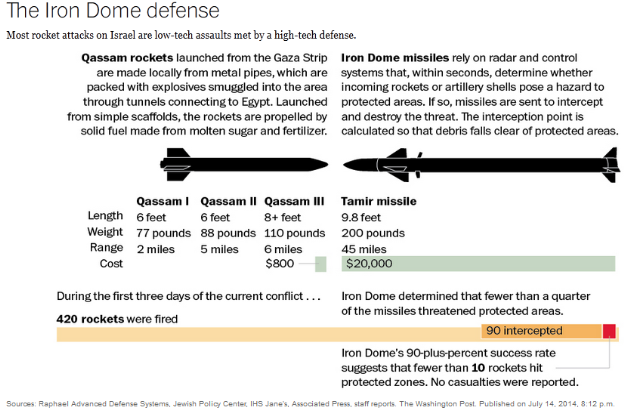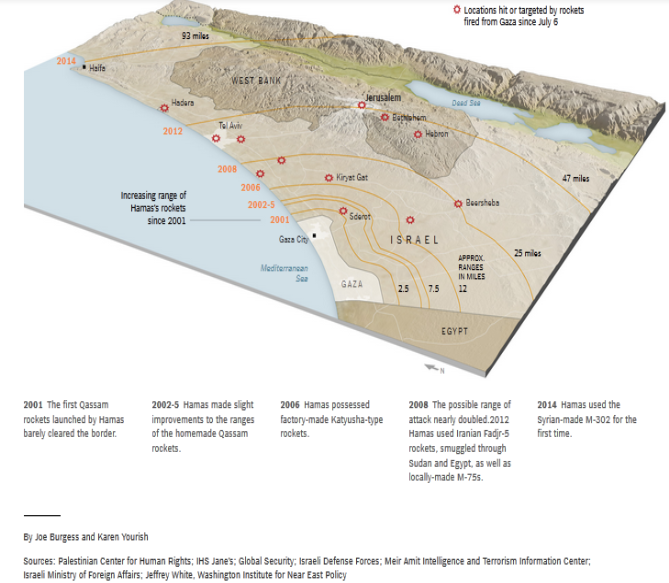CRS Insights
Events on July 6-7, 2014, transformed periodic attacks between Palestinian militants in the Gaza Strip and Israel's military into a larger conflict between Israel and the Gaza-based Islamist group Hamas. Since then, Hamas and other Palestinian militants have reportedly launched more than 1,000 rockets into Israel with longer ranges than in past conflicts, and Israel has conducted more than 1,500 air- and sea-based strikes on targets in Gaza. Rockets and/or mortars have also reportedly been fired on Israeli-controlled territory from Lebanon, Syria, and Egypt's Sinai Peninsula, in some cases provoking Israeli retaliatory fire. Additionally, Israel has conducted at least one commando raid against a Gaza military target, and has reportedly shot down a Hamas drone aircraft and foiled a Hamas sea raid. Though casualty figures cannot be independently verified, apparently more than 180 Palestinians—many or most of them civilians, but also some prominent Hamas operatives—have been killed, more than 1,300 injured, and several thousand displaced. Injuries to a number of Israeli civilians and military personnel have been reported. Daily life on both sides faces continual disruption. Israel's Iron Dome anti-rocket system has reportedly intercepted approximately 90% of rockets it classifies as threats to sensitive targets (including population centers).
 |
 |
|
Source: New York Times |
Despite U.S. and international calls and efforts to end the violence, including a July 12 U.N. Security Council statement, hostilities have continued to date. On July 15, Israel reportedly accepted an Egyptian proposal that would temporarily halt violence pending negotiation of a comprehensive cease-fire, but Hamas and other Palestinian militants have balked at the proposal. Israel has warned that a ground operation may be imminent if Palestinian rocket attacks continue. Israeli troops have been deployed to the Gaza border and more than 40,000 reserves have been called up.
On July 11, the House passed a resolution (H.Res. 657) calling on Hamas to immediately cease all attacks and expressing its support for Israel's right to defend itself. A similar resolution in the Senate (S.Res. 498) is under consideration, with a provision calling on Palestinian Authority (PA) President and Fatah leader Mahmoud Abbas to dissolve the PA government formed in early June 2014 in consensus with Hamas.
Background
The current violence occurs within a political context marked by increased Israeli-Palestinian tensions. These tensions have been fueled by, among other factors, mutual recriminations surrounding the unsuccessful end to a round of U.S.-backed negotiations in April 2014, and the June formation of the PA consensus government.
|
Major Israel-Hamas Conflicts Since 2008 December 2008-January 2009: Israeli codename "Operation Cast Lead" Three-week duration, first meaningful display of Palestinians' Iranian-origin rockets, Israeli air strikes and ground offensive Political context: Impending leadership transitions in Israel and United States; struggling Israeli-Palestinian peace talks (Annapolis process) November 2012: Israeli codename "Operation Pillar of Defense (or Cloud)" Eight-day duration, Palestinian projectiles of greater range and variety, Israeli airstrikes, prominent role for Iron Dome Political context: Widespread Arab political change, including rise of Muslim Brotherhood to power in Egypt; three months before Israeli elections July 2014: Israeli codename "Operation Protective Edge/Mighty Cliff" Escalated July 6-7, Palestinian projectiles of greater range and variety, Israeli air strikes, prominent role for Iron Dome Political context: Shortly after (1) unsuccessful round of Israeli-Palestinian peace talks, (2) PA consensus government formation and end of Hamas's formal responsibilities for governing Gaza, (3) prominent youth killings. |
In mid-June, Israel carried out numerous raids and detentions in the West Bank after the abduction of three Israeli teenagers. Daily Palestinian rocket barrages followed against Israel from Gaza (initially reportedly led by non-Hamas groups). After the teenagers were found murdered on June 30, and the two Palestinian suspects (to date still at large) were claimed by Israel to have Hamas connections (though Hamas denies responsibility), Israeli Prime Minister Binyamin Netanyahu vowed a strong response. On July 2, a Palestinian teenager in Jerusalem unconnected with the incident was burned to death—allegedly in retaliation—by a group of Jewish Israeli extremists. Despite Netanyahu's public condolences for the death of the Palestinian youth and the subsequent arrest and confession of three suspects, Palestinian protests (which have since abated) broke out in East Jerusalem and several Israeli towns with large Arab communities, and Israel-Gaza violence continued. After a July 6 Israeli air strike against a tunnel leading from Gaza to Israel reportedly killed six Hamas operatives, Hamas actively took the lead in conducting rocket attacks on Israel, and the conflict escalated.
Assessment
This is the third major conflict between Israel and Hamas in the past six years. Though distinct, each arguably has featured mutual tests of military capability, domestic political cohesion, and deterrence in times of political change. Each has also featured heated debate over respective culpability and the targeting of civilians.
In this case, Israel appears to be seeking to deter Hamas and hold it and/or PA President Abbas accountable for threats to Israel resulting from Gaza's complex political, social, and economic dysfunction (see CRS Report RL34074, The Palestinians: Background and U.S. Relations, by Jim Zanotti). In addition to Hamas's longstanding demands to have Israeli and Egyptian restrictions on access to and from Gaza significantly eased, the group may be trying to show Israel that recent political setbacks have not weakened its military capabilities. It may also be striving to reinforce its credentials as a resistance movement in order to gain politically at Abbas's expense and stave off challenges from other armed groups in Gaza.
U.S. Policy Issues
Congress and the Obama Administration might address a range of issues pertinent to the conflict, including:
- Whether and how to intercede to end the conflict and avoid spillover into third countries or a third Palestinian intifada (uprising);
- Whether various Israeli and Palestinian actions comply with international laws and norms, and how to respond to any breaches;
- What implications there are for Palestinian unity, diplomacy and international action regarding Israeli-Palestinian disputes, and regional dynamics; and
- Whether and how various types of material and political assistance to Israel and the Palestinians might proceed, change, or cease (see CRS Report RL33222, U.S. Foreign Aid to Israel, by Jeremy M. Sharp and CRS Report RS22967, U.S. Foreign Aid to the Palestinians, by Jim Zanotti).
